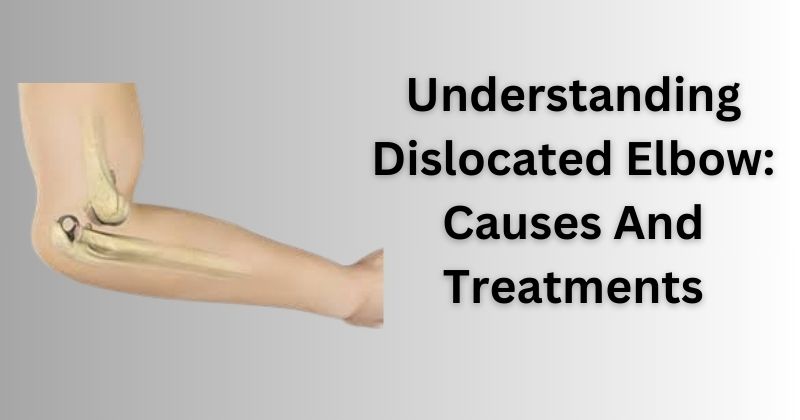A dislocated elbow is a traumatic injury that can cause significant pain and discomfort. It occurs when the bones of the elbow joint are forced out of their normal positions, disrupting the joint’s structure and its ability to move properly. This condition is most common in children and young adults, particularly those involved in activities like sports or outdoor activities that increase the risk of falls and injuries. Understanding the causes, symptoms, treatment options, and recovery time for a dislocated elbow is essential for anyone who may experience or care for someone with this injury.
What is a Dislocated Elbow?
A dislocated elbow happens when the humerus (upper arm bone) and the radius and ulna (forearm bones) are displaced from their normal alignment at the elbow joint. The elbow joint is a hinge joint that allows the forearm to move relative to the upper arm. When this alignment is disrupted, it can lead to pain, swelling, and difficulty moving the arm. A dislocated elbow can be accompanied by other injuries, such as fractures of the bones or damage to the surrounding ligaments and tendons.
Causes of a Dislocated Elbow
Dislocated elbows are most often caused by trauma. Here are some of the main causes:
- Falls: One of the most common ways to dislocate an elbow is by falling onto an outstretched arm. This often occurs during sports activities like football, basketball, or skateboarding, but it can also happen in everyday situations such as slipping on a wet surface or stumbling.
- Direct Impact or Blows to the Elbow: Car accidents, sports collisions, or any other incidents where there’s a significant force directly applied to the elbow can cause the bones to shift out of place.
- Hyperextension: If someone forces the elbow into an unnatural position, such as bending it backward (hyperextension), it can result in a dislocation.
- Rotational Force: Sometimes, a rotational force applied to the arm causes a dislocated elbow, like in certain contact sports or during activities where someone twists or turns the arm too far.
Symptoms of a Dislocated Elbow
The symptoms of a dislocated elbow can be quite obvious, though sometimes they may be confused with other injuries. The most common signs include:
- Intense Pain: The most immediate symptom is sharp pain at the elbow joint, which may increase with any movement.
- Swelling and Bruising: The area around the elbow will often swell quickly, and bruising may develop as well.
- Limited Range of Motion: The injured person will be unable to bend or straighten the arm due to the misalignment of the bones.
- Deformity: In severe cases, the elbow may appear visibly deformed, with the joint taking on an abnormal shape.
- Numbness or Tingling: If the dislocation affects the nerves, the person may experience numbness or a tingling sensation in the hand or fingers.
Dislocated Elbow Treatment: Easy Methods and Steps
Treatment for a dislocated elbow depends on the severity of the injury. Generally, the first step is to reduce the dislocation, which means realigning the bones. A medical professional typically performs this process in a hospital setting. Here’s a look at the steps in treating a dislocated elbow:
Immediate Care:
- Stabilization: Until medical help arrives, it is important to stabilize the arm. Avoid trying to move the arm or force the elbow back into place, as this can cause further damage to the joint, nerves, and blood vessels.
- Cold Compress: Applying ice to the affected area can help reduce swelling and pain. Wrap a cold compress in a cloth or towel and apply it for 15-20 minutes every couple of hours. When you force the bones of the elbow joint out of their normal positions, you disrupt the joint’s structure and its ability to move properly.
Medical Intervention:
- Reduction (Realignment): In a hospital or clinic, a healthcare provider will use specific techniques to gently realign the bones back into place. The medical team may perform this under sedation or local anesthesia to ensure the patient is as comfortable as possible.
- X-rays: Doctors take X-rays to confirm the dislocation and check for fractures or other injuries that may accompany the dislocation.
Post-Treatment Care:
- Splinting or Casting: After the doctor realigns the elbow, they typically immobilize the joint in a splint or cast to prevent movement and allow for healing.
- Pain Management: Healthcare providers may prescribe over-the-counter pain medications, such as ibuprofen or acetaminophen, to help manage pain and swelling. Stronger medications may be necessary in some cases.
Physical Therapy:
- Rehabilitation: Once the elbow begins to heal, physical therapy plays a key role in restoring strength and range of motion. Rehabilitation exercises will focus on gradually rebuilding flexibility and strength in the elbow joint, allowing the person to return to normal activities.
- Gentle Stretches: These can help ease stiffness in the elbow and improve flexibility.
- Strengthening Exercises: As the elbow heals, strengthening exercises will help rebuild muscle strength around the joint.
Surgical Intervention:
In rare cases, when there are complex fractures or the ligaments and tendons are severely damaged, surgery may be necessary. Surgical intervention can help repair broken bones, torn ligaments, and damaged soft tissues.
Easy Dislocated Elbow Recovery Time
The dislocated elbow recovery time depends on several factors, including the severity of the injury, whether there were any accompanying fractures, and how well the person follows the prescribed rehabilitation plan.
- Mild Dislocation: For a mild dislocation where there are no fractures, the recovery time is typically between 6 to 8 weeks. During this time, the patient will need to rest the elbow, follow a pain management regimen, and engage in physical therapy.
- Severe Dislocation: If the dislocation is accompanied by fractures, or if surgery is required, the recovery time can be extended to 12 weeks or longer. The patient may need to wear a cast or splint for an extended period, followed by more intensive physical therapy.
During the recovery period, it is important to avoid putting weight or stress on the affected elbow, as this can delay healing. Regular check-ups with the doctor will ensure that the joint is healing properly and that there are no complications.
Preventing a Dislocated Elbow
While it may not always be possible to prevent a dislocated elbow, there are steps that can reduce the risk:
- Wear Protective Gear: In sports or activities where falls are common, wearing elbow pads and other protective gear can help protect the joint from injury.
- Practice Safe Movements: Learning proper techniques for physical activities, such as sports, can reduce the risk of falls and injury. Avoiding risky behaviors that involve excessive twisting or hyperextension of the elbow is also important.
- Strengthening Exercises: Building strength in the muscles surrounding the elbow joint can help support it and prevent dislocations caused by weak muscles or instability.
Conclusion
A dislocated elbow is a painful injury that requires immediate medical attention. With proper treatment and a structured rehabilitation plan, most people can fully recover and return to normal activities. Whether healthcare professionals provide easily dislocated elbow treatments, pain management, or gradual strengthening exercises, the key to recovery lies in following their advice and allowing the elbow to heal properly. Understanding the causes, treatments, and recovery timeline can help individuals navigate through this injury and reduce the risk of future complications.
For more(click here)



